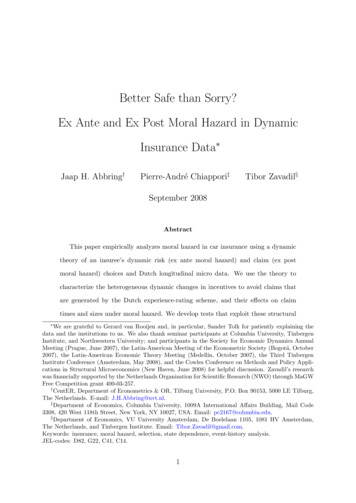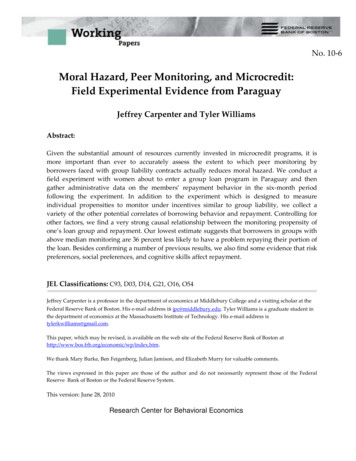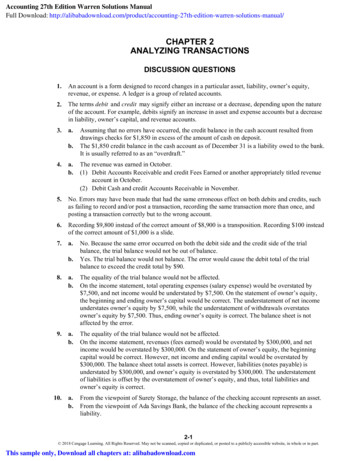
Transcription
Credit Guarantees, Moral Hazard, and theOptimality of Public Reserves Matthias DoepkeyUCLARobert M. TownsendzUniversity of ChicagoAugust 2001AbstractIn this paper we show that public reserves with a low return and a partial creditguarantee scheme can be optimal if banks face a moral hazard problem with both hidden actions and hidden information. In our model, banks face uncertain returns ontheir loans or investments, and both the level of investment and the actual returns areunobservable to anyone but the bank itself. We formulate the problem of providingoptimal incentive-compatible credit insurance to the banks, and find that the optimalcontract has the feature that low-return public reserves are used. This occurs eventhough public reserves are dominated in return by other investments, and would notbe used in a full-information environment. In order to compute the optimal partial insurance scheme, we develop general recursive methods to solve for optimal contractsin dynamic principal-agent models with hidden income and hidden actions. Weare grateful to Harold Cole, Hugo Hopenhayn, Ruilin Zhou, and seminar participants at Chicago,MIT, Boston University, IIES, and the SED meeting in San Jose for helpful comments.y Department of Economics, UCLA, Box 951444, Los Angeles, CA 90095.E-mail address:doepke@econ.ucla.edu.z Department of Economics, The University of Chicago, 1126 East 59th Street, Chicago, IL 60637. E-mailaddress: rtownsen@midway.uchicago.edu.1
1IntroductionWe consider the problem of providing optimal incentive-compatible insurance in an environment where banks face uncertain returns on their loans or investments, and the levelof investment and the actual returns on investment are unobservable to anyone but thebank itself. The model that we use to analyze the role of public reserves is thus a representative of a wider class of models with unobserved states and unobserved actions.In such environments, optimal allocations cannot be computed with standard methods,since the number of incentive constraints becomes too large. We develop recursive methods to solve for optimal incentive-compatible contracts that require only a relatively smallnumber of constraints.In dynamic principal-agent models with unobserved income shocks the principal generally needs some control over the intertemporal rate of substitution of the agent in orderto induce the agent to report his income truthfully. Controlling the intertemporal rate ofsubstitution becomes difficult, however, if the agent can take unobserved actions that influence his future consumption possibilities. Indeed, Allen (1985) shows that if the agenthas unobserved access to borrowing and lending in a perfect credit market, the principal cannot offer any additional insurance. The reason is that any agent will choose thereporting scheme that yields the highest net discounted transfer regardless of what theactual endowment is. The planner is no longer able to distinguish agents with low andhigh endowments.For real-world applications, an important question is what the optimal insurance schemelooks like if the agent can take hidden actions that are different from accessing a perfect credit market. Examples of such actions include risky investments, or storage at areturn lower than the credit-market interest rate. In this paper, we present methods tocompute the optimal insurance contract in a wide class of such environments. We applyour methods to a banking model where bankers face uncertain returns on their investments, and both the level of investment and the realized return are observed only by thebankers themselves. We show that in this environment an insurance scheme can arisein which high-yielding private investments and low-yielding public reserves coexist. Inother words, our model provides a new rationale for bank reserves. Reserves arise as afeature of the optimal insurance contract in an environment characterized by moral hazard. The traditional justification for public reserves, the need to provide liquidity, doesnot play a role in our formulation.2
The setup of our banking model is as follows. A large number of bank owners or investors are trying to decide on their own investment strategies and whether or not toadopt some kind of collective credit guarantee scheme. Each bank owner/investor, givenhis own unobserved income, has to decide on his current consumption compensation,how much to take out of the bank, as well as the amount to invest in a variety of riskyloans, assets that have an uncertain payoff in income next period. Other things equal,each bank owner/investor would like to smooth out next period’s income fluctuations.There are two ways to do that smoothing. One way is for all bank owner/investors toremain on their own, to respond to higher income this period by consuming more andalso saving more, that is investing more in risky loans, though the return on those loansnext period remains uncertain. A second way is for bank owner/investors to get togetherand collectively insure one another against loan default, that is, levying premia whenportfolios are successful and paying indemnities against the low yields of some of theprojects financed with bank loans. In effect this is like a deposit insurance scheme, anattempt to stabilize returns on investment against the risk in loan portfolios, but here itis the bankers’ money that is at risk and the loan return the risk that is insured. Thepossibility of such a scheme is limited, however, if the level of investment and realizedinvestment returns are unobserved. The bank then becomes a ‘black box’, with all theinner workings hidden to outsiders. More formally, the classic moral hazard problemarises: A low current-period level of investment makes high returns less likely next period, so if loan default were insured completely, and levels of investment were not known,no banker would invest or be diligent and all would claim indemnities. Recall again thatinvestment comes at the expense of current consumption levels, and private, unobservedinvestment cannot be required.Yet an alternative partial insurance or loan guarantee scheme is possible. Bank ownerscan set up a separate public reserve fund financed with premia but with more limitedpossibilities for indemnities. Money placed in this fund is under collective control and canbe put into low-yield but safe assets. The advantage of the fund is that there is presumedto be no moral hazard problem, so next periods relatively low returns can be used tocompensate bank owners with bad loans. For a variety of parameter values it turns out tobe optimal for bank owners to to pay premia into the public fund. While the bank ownersstill invest in loans, they are doing less internal investing than they would if they wereentirely on their own. Surprisingly, the insurance gain from the public reserve fund is solarge that it can under certain parameter values dominate what might seem to be more3
efficient investment. That is, at an optimum, the average yield from more liberal internalinvestment among bank owners can dominate the yield-safe asset, but still it is optimalto set up the public reserve. The reason is that eliciting the information about actual loanyields under the more liberal policy would be too costly in terms of incentives. Also,since bank owners invest less in risky loans when the reserve fund is used, the variabilityof their income in the next period is reduced, further mitigating the original insuranceproblem. In effect, we have created a rational for reserves.This policy only disappears when the economy’s internal rate of return (i.e., the averagereturn on investments) is so high that it makes sense for the public authority to issue itsown bond, that is, borrow from outsiders, and lend to the bankers. Even here, however,some insurance is still possible in the sense that the bank with successful loan portfolios pay back more to the public authority than do those with loan defaults. In effect,though all bankers might appear collectively to be borrowing at the outside rate, a riskcontingency kicks in for those with loan defaults.On the other hand, when the economy’s internal rate of return is low (though possibly stillhigher than the rate of return on public reserves) in the optimal insurance scheme bankersdo not invest at all in risky assets with unobserved returns. All intertemporal smoothingis provided through safe investments with observed returns by the fund. Here we observethe seemingly perverse situation that the utility of the bankers depends negatively on thereturn of investment projects. Even though in the optimum the investment projects arenot used at all, their rate of return still influences the optimal allocation. With a high rateof return, it is more difficult to provide incentives for truthful reporting, and consequentlyless insurance is possible.Our results here are related to a literature on the optimality of public insurance, or ironically, how public insurance can be non-optimal. The idea in Attanasio and Rios-Rull(2000) is that the provision of public insurance for aggregate shocks can undercut selfsustaining private insurance against idiosyncratic shocks. Most of the models feature limited commitment, rather than private information, and people continue to participate inprivate schemes only as they weigh the benefit of future participation, insurance againsta bad shock, against the current cost, e.g., of paying a premium now. Of course, such insurance is most valuable when one needs it most, particularly when aggregate shocks areperverse. Thus publicly engineered transfers to those adversely affected, which ceterisparibus can be a good thing, can undercut some of the benefits of private transfers, andthis latter effect can, depending on parameter values, be large enough as to cause a net4
welfare loss. The result is related to Perri and Krueger (1999) who show that progressivetaxation can have perverse effects, and to Ligon, Thomas, and Worrall (2000) who showthat private storage in an insurance context can have the same perverse effect.Our model here concentrates on moral hazard and hidden information. We show thathigh-yielding private investments can coexist with low-yielding public investments inthe optimum, and that higher returns on private uncontrolled investment that wouldbe welfare improving in autarky can have a perverse welfare effect to the informationconstrained optimum. However, one thing which sets our paper apart from the literatureis that we do not suppose that the public aspect of insurance are imposed exogenouslyand suboptimally onto the privately optimizing agents. Rather, we solve a mechanismdesign problem which derives the optimal public policy. In effect there is little distinctionbetween the public and the private sector. We might equally well expect the reservefund schemes we described to be adopted by the private sector or to be imposed by anoptimizing government. We only know that some kind of collectivity is required.Our results appear related to several private and public schemes we have observed in thepast or observe contemporaneously. In typical contemporary deposit insurance schemesthe public puts money in demand deposits and financial institutions and the funds are,in turn, put via loans into long-term and potentially illiquid projects. There is a risk thatdeposits will need to be withdrawn, and that a bank will find itself unable to meet thedemand. To guard against that, financial institutions are required to put some of theirassets into liquid if low-yielding reserves. Banks also pay premia into an insurance fund.In turn, when faced with excessive withdrawals, the bank can draw on reserves and ifnecessary get an indemnity from the fund. Though reserves and deposit insurance fundsare nominally used to guard against liquidity, not insolvency problems, the boundaryin practice is less than clear. In any event, in our setup, we do not make a distinctionbetween short term low yield assets, on the one hand, and long term high yield assets onthe other. Neither do we make a distinction between liquidity and insolvency. The banksof our model do on occasion suffer from genuinely low portfolio yields, and subject tomoral hazard and hidden information problems, it is precisely this risk that they wish toand are able to partially insure.Other historically observed schemes seem to have similar group insurance aspects. Muchwork has been done lately in understanding the Suffolk Bank system. Groups of privatebanks in the New England area with circulating notes agreed voluntarily to put some oftheir assets into the Suffolk Bank. In turn the Suffolk Bank would redeem individual bank5
notes at par, even when a given bank was under stress or failed. Apparently notes thuscirculated at par over a wide geographic area, whereas prior to the Suffolk Bank system,notes circulated at an increasing discount the further from the issuing bank.While our emphasis is on credit guarantees, the methods developed in this paper can beapplied to a more general class of models with hidden endowments and hidden actions.Other examples include hidden storage with an arbitrary return, including storage ofgrain at a loss, or holding money in an inflationary world. In such environments, optimalallocations cannot be computed with standard methods, since the number of incentiveconstraints becomes too large.On the technical side, the main contribution of this paper is to develop recursive methodsto solve for optimal incentive-compatible contracts that require only a relatively smallnumber of constraints and can be computed using current computer technology. Thekey feature of our formulations is that they allow the planner to specify behavior off theequilibrium path, which leads to a dramatic reduction in the number of constraints thatneed to be imposed when computing the optimal contract. Some of our computationaltechniques derive from Prescott (1997). Specifically, Prescott introduced off-path utilitybounds to reduce the dimensionality of private-information problems. While he concentrates on a static moral-hazard model, we extend the method to a dynamic framework.Our paper is also related to Fernandes and Phelan (2000). Fernandes and Phelan developrecursive methods to deal with dynamic incentive problems with links between the periods, and as we do, they use a vector of utility promises as the state variable. The maindifference is that Fernandes and Phelan do not consider environments in which both actions and states are unobservable to the planner, which is the main source of complexityin our setup. Werning (2001) develops a recursive first-order approach to compute adynamic moral hazard problem with storage. Werning’s method applies to a more restricted setting in which output is observed, the return on storage does not exceed thecredit-market return, and storage is not subject to random shocks. We regard his methods as complementary to ours, since the computational cost of the first-order approach islower as long as it is justified. Another feature of our approach is that we start from a general setup which allows randomization and unrestricted communication, and show fromfirst principles that our recursive formulations are equivalent to the original formulation.A related theoretical paper is Cole and Kocherlakota (2001). Cole and Kocherlakota consider the special case of an economy in which the agent can only save, but not borrow.6
They find that as long as the return on storage is sufficiently high (the gross return has tobe at least as high as the inverse of the discount factor), the optimal allocation is equivalent to access to a perfect credit market. As in Allen’s result, no insurance is possiblebeyond self-insurance using borrowing and lending. Cole and Kocherlakota interpretthis outcome as a microfoundation for missing security markets, since the optimal allocation can be decentralized using one-period bonds only. Our methods can be used tocompute optimal outcomes in a similar environment with a lower return on savings, orin environments with a wedge between borrowing and lending rates. The issue of unobserved access to credit markets is also discussed in Fudenberg, Holmstrom, and Milgrom(1990), who derive conditions under which optimal dynamic incentive contracts can beimplemented as a sequence of short-term contracts, one of the conditions being that theprincipal and agent can access the credit market on equal terms.The paper is organized as follows. In Section 2 we introduce the economic environmentthat underlies our mechanism design problem. Section 3 develops four different recursive formulations for the planner’s problem. All formulations are linear programs, butthey differ in their computational needs (that is, the number of variables and constraints).In Sections 4 and 5 we apply our computational methods to the banking environmentdescribed above, and show how public reserves arise as the optimal solution to a mechanism design problem. Section 6 discusses a number of additional numerical examples.Section 7 concludes.All proofs are contained in the mathematical appendix. Section A.1 introduces a generalformulation of our mechanism design problem with arbitrary message spaces and fullhistory dependence. Sections A.2 to A.5 derive the recursive representations that wereintroduced in Section 3 from this general version, and show that all formulations areequivalent.2A General Principal-Agent Model with Hidden Statesand Hidden ActionsIn the following sections we develop a number of recursive formulations for a generalmechanism design problem, with the aim to provide a formulation that lends itself easilyto numerical computation. For maximum generality, when deriving the different recursive formulations we concentrate on the case of infinitely many periods with unobserved7
endowments and actions in every period. With little change in notation, the formulations can be adapted to models with finitely many periods and/or partially observableendowments and actions.The physical setup is identical for all programs that we consider. At the beginning of eachperiod the agent receives an endowment e from a finite set E . The endowment cannot beobserved by the planner. Then the planner gives a transfer from a finite set T to theagent. At the end of the period, the agent takes an action a from a finite set A. Again, theaction is unobservable for the planner. In most examples below we will concentrate onpositive a and interpret them as storage, but without any changes in the setup we couldalso allow for a to be negative, which can be interpreted as borrowing. The interpretationis the usual small-economy one, with unrestricted access to outside credit markets. Theagent consumes the amount e a, and enjoys period utility u(e a). Our methodsdo not require any specific assumptions on the utility function u( ), apart from it beingreal-valued.The action a influences the probability distribution over the endowment in the next period. Probability p(eja) denotes the probability of endowment e if the agent took actiona in the previous period. For tractability, we assume that all states occur with positiveprobability, regardless of the action:Assumption 1 The probability distribution over the endowment e satisfies p(eja) e 2 E , all a 2 A.0 for allIn the first period the probability p(e) of endowment e does not depend on any prioractions.Apart from physical transactions, there is also communication taking place between theagent and the planner. We do not place any prior restrictions on this communication, inorder not to limit the attainable outcomes. At a minimum, the agent has to be able senda signal about his endowment, and the planner has to be able to send a recommendationfor the action.In what follows Q is the discount factor of the planner, and is the discount factor ofthe agent. The planner is risk-neutral and minimizes the expected discounted transfer,while the agent maximizes discounted utility. Another interpretation is that there is acontinuum of agents with mass equal to unity. In that case, the probability of an event8
represents the fractions in the population experiencing that event. The discount factorQ is given by Q 1 1 r , where r is taken to be the outside credit-market interest rate forborrowers and lenders. When the discounted surplus is zero, we have attained a Paretooptimum. We assume that both discount factors are less than one so that utility is finiteand our problem is well defined.Assumption 2 The discount factors Q and0 1.of the planner and the agent satisfy 0 Q 1 andWhen there are only finitely many periods, we only require that both discount factors arebigger than zero, because utility will still be well defined.3Recursive FormulationsIn this section, we present a series of recursive formulations of the general problem. Themain issue that we have to deal with is that the presence of hidden actions and hiddenstates implies a large number of incentive constraints. The most straightforward formulations of the problem are therefore computationally infeasible once grids get large.From the outset, we work with a recursive formulation that uses a vector of promisedutilities as the beginning-of-period state variable. In the Mathematical Appendix we providea formal justification of this setup. The planner promises to deliver utility w (e) in case statee gets realized. The entire vector of promised utilities is denoted w. The planner has abeginning-of-period value function V (w; e) that gives the planner’s expected discountedsurplus if the vector of promised utilities is w and state e is realized.#E is the number of gridpoints for the endowment, #T is the number of possible transfers, and #A is the numberWe assume that there are finite grids for all choice variables.of actions. The vector of promised utilities is also assumed to be in a finite set W, andthe number of possible choices is #W. We restrict attention to finite grids in order to beable to solve the model on the computer. Infinite sets can be approximated by making thenumber of points in the grid large.The choice of the set W is not arbitrary, because there are utility vectors that cannot beimplemented by the planner. For example, because both endowment and action are unobserved, the planner will never be able to assign higher utilities to lower endowments9
than to higher endowments. On the other hand, we can be sure that at least some utilityvectors are feasible, because the planner can always decide to make the transfer not depend on the endowment, and assign the utilities that result from this policy. In practice,we determine the set W numerically. We start with a fine grid, and throw out all pointsthat turn out to be infeasible.3.1 A Direct ApproachWe start with the most straightforward formulation of the problem. The agent comesinto the period with a vector of promised utilities w. At the beginning of the period, thestate e is realized, and the agent makes a report about the state to the planner. Conditional on this report, the planner delivers a contract consisting of lotteries over transfer ,recommended storage a, and promised utilities for the next period w0 . The planner maximizes surplus subject to promise-keeping and incentive-compatibility constraints. Themaximization problem of the planner defines a functional equation in the value functionV (w; e).Program 1:The maximization problem of a planner who has promised vector w and has received reporte is:V (w; e) max 0XWT;A; 0 ( ; a; w0jw; e)h QiXEp(e0 ja)V (w0; e0 )(1)subject to the constraints (2) to (5) below. The first constraint is that the ( ) sum to one toform a probability measure:XWT;A; 0 ( ; a; w0jw; e) 1:(2)Second, the contract has to deliver the utility that was promised for state e:XWT;A; 0h ( ; a; w0jw; e) u(e a) 10iXEp(e0 ja)w0(e0 ) w(e):(3)
Third, the agent needs incentives to be obedient. For each transfer and recommendedaction a, the agent has to prefer to take action a over any other action a 6 a:8 ; a; a 6 a :XW0h ( ; a; w0jw; e) u(e XW0Xa ) Eh ( ; a; w0 jw; e) u(e a) p(e0 ja )w0 (e0 )iiXEp(e0 ja)w0 (e0 ) :(4)Finally, the agent needs incentives to tell the truth, so that no agent with endowment e would find this branch attractive. Under the promised utility vector w, agents at e shouldget w ( e). Thus. an agent who actually has endowment e but says e nevertheless must notget more utility than was promised for state e . This has to be the case regardless whetherthe agent follows the recommendations for the action or not. Thus, for all states e and allfunctions Æ : T A ! A mapping transfer and recommended action a into an actionÆ ( ; a) actually taken, we require:8e ; Æ :XWT;A; 0h ( ; a; w0jw; e) u( e Æ ( ; a)) iXEp(e0 jÆ ( ; a))w0(e0 ) w( e):(5)Note that similar constraints are written for the e problem, so that agents with e receivew( e) from a constraint like (3). Of course, there are #E problem 1’s to solve.The problem with this version is that the number of truth-telling constraints is very large.For each state e there is a constraint for each function Æ : T A ! A, and there are(#A)(#T #A) such functions. Unless the grids for and a are rather sparse, memory prob-lems make the computation of this program infeasible. The total number of variables inthis formulation, the number of objects under ( ), is #T #A #W. There is one probability constraint (2) and one promise-keeping constraint (3). The number of obedienceconstraints (4) is #T #A (#A 1), and the number of truth-telling constraints (5) is#E (#A)(#T #A) . As an example, consider a program with two states e, ten transfers, two actions a, and ten utility vectors w0. With only ten points, the grids for transfersand utility promises are rather sparse. Still, for this example and a given vector of utilitypromises w and realized state e Program 1 is a linear program with 200 variables and2,097,174 constraints. If we increase the number of possible actions a to ten, the numberof truth-telling constraints alone exceeds 10100 , which is well above current estimates ofthe number of atoms in the universe. Clearly, such programs will not be computable nowor any time in the future.11
It is especially harmful that the grid size for the transfer causes computational problems,as it does here because of the dimensionality of Æ ( ; a). One can imagine economic environments in which there are only a small number of options for actions available, but it ismuch harder to come up with a reason why the planner should be restricted to a small setof transfers. In the next section we present a method to deal with this specific problem.Afterwards, we will develop formulations that are also capable of computing solutions inenvironments with many actions.Before we proceed to the next formulation, we need to address what happens in the veryfirst period. At the beginning of time the agent does not yet have a utility vector assigned.Instead, we want to trace out the Pareto frontier by varying an initial utility promise W0 ,a scalar, to the agent. By varying W0 we can compute the utility of the planner V (W0 ),and in this way trace out the entire ex ante Pareto frontier. The maximization problem ofthe planner in period zero is:V (W0 ) max 0XWE;T;A; 0 ( ; a; w0jW0 ; e)p(e)h QiXEp(e0 ja)V (w0; e0 )(6)subject to the constraints (7) to (10) below. The first constraint is that the contracts haveto be probability measures for each e:8e :XWT;A; 0 ( ; a; w0jW0 ; e) 1:(7)Second, the contracts have to deliver promised utility W0 :XE;T;A;W0h ( ; a; w0jW0 ; e)p(e) u(e a) iXEp(e0 ja)w0(e0 ) W0 :(8)Third, the agent has to be obedient in case he told the truth about e. For each state e,transfer , recommended action a, and alternative action a 6 a we require:8e; ; a; a 6 a :XW0h ( ; a; w0 jW0 ; e) u(e XW0ha ) ( ; a; w0jW0 ; e) u(e XEa) p(e0 ja )w0 (e0 )iiXEp(e0 ja)w0 (e0 ) :(9)Finally, the agent has to tell the truth and be obedient. For each actual state e, counterfac-12
tual state e and each function Æ : T8e; e ; Æ :Xh ( ; a; w0jW0 ; e ) u(e W0 XT;A; A ! A we require:WT;A; 0Æ ( ; a)) h ( ; a; w0jW0 ; e) u(e a) iXEp(e0 jÆ ( ; a))w0 (e0 )Ep(e0 ja)w0(e0 ) :iX(10)This method of handling the first period is especially useful if we restrict attention to atwo-period model. V (w; e) on the right-hand side of (6) is then the value function forthe second period as in the left-hand side of (1), with the future, third period suppressed.Given the value function for the second period, we only have to compute the above singleprogram to find the optimal contract in the first period for a given promised utility W0 .One does not have to iterate on a functional equation to find V (w; e) in (1), and hence theoptimal ( ).Models with a finite number of periods can be solved in the same way with a finitenumber of iterations. In an infinite-period setting we do need to find the value function V (w; e), that is, V (w; e) in (1) is a solution to a functional equation, found in practiceby iteration to convergence. It is therefore more efficient in period zero to use that function V (w; e) to trace out the Pareto frontier. This can be done by letting the planner offer alottery (wjW0 ) over utility vectors w before the first period starts and before e is known.The problem of the planner is:V (W0 ) max 0XW (wjW0)hXip(e)V (e; w)E(11)subject to a probability and a promise-keeping constraint:XWXW (wjW0 ) (wjW0) 1:hX(12)iEp(e) w(e) W0:(13)This method is simpler in the infinite-period setting, and it is the one that we use with allother formulations below.We will now develop a different formulation of the problem with a much smaller numberof incentive constraints.13
3.2 Double ReportingThe basic idea of this section is to divide the period into two parts
Credit Guarantees, Moral Hazard, and the Optimality of Public Reserves Matthias Doepke y UCLA Robert M. Townsend z University of Chicago August 2001 Abstract In this paper we show that public reserves with a low return and a partial credit-guaranteeschemecanbe optimalifbanks face amoral hazard problemwithbothhid-den actions and hidden information.










